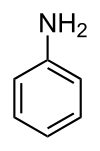
Aniline
Aniline is a toxic organic compound with the formula C6H5NH2. Consisting of a phenyl group attached to an amino group, aniline is the prototypical aromatic amine. Its main use is in the manufacture of precursors to polyurethane and other industrial chemicals. Like most volatile amines, it possesses the odor of rotten fish. It ignites readily, burning with a smoky flame characteristic of aromatic compounds.
Production
Industrial aniline production involves two steps. First, benzene is nitrated with a concentrated mixture of nitric acid and sulfuric acid at 50 to 60 °C to yield nitrobenzene. The nitrobenzene is then hydrogenated (typically at 200–300 °C) in the presence of metal catalysts.
The reduction of nitrobenzene to aniline was first performed by Nikolay Zinin in 1842 using inorganic sulfide as a reductant (Zinin reaction).
Aniline can alternatively be prepared from ammonia and phenol derived from the cumene process.
In commerce, three brands of aniline are distinguished: aniline oil for blue, which is pure aniline; aniline oil for red, a mixture of equimolecular quantities of aniline and ortho- and para-toluidines; and aniline oil for safranine, which contains aniline and ortho-toluidine, and is obtained from the distillate (échappés) of the fuchsine fusion.
Podcasts:

-
by Johnny Hallyday
-
by Johnny Hallyday
-
by Johnny Hallyday
-
by Johnny Hallyday
-
by Johnny Hallyday
-
by Johnny Hallyday
-
by Unlight
-
by Unlight
-
by Unlight
-
by Unlight
-
by Unlight
-
by Unlight
-
by Unlight
-
by Unlight
-
by Unlight
-
by Unlight
-
by Unlight
-
by Unlight
-
by Unlight
-
by Unlight
-
by Unlight
-
by Unlight
-
by Unlight
-
by Unlight
-
by Unlight
-
by Unlight
-
by Unlight
-
by Unlight
-
by Unlight
-
by Unlight
-
by Unlight
Celui Qui T'a Fait Pleurer
by: Johnny HallydayJamais, jamais
On ne tiendra ma vie
Comme toi, tu vois
Je suis pris
Toujours, l'amour
C'est près de toi
Que mon cœur l'a désiré
Qu'il revienne
Qu'il revienne
Celui qui t'a fait pleurer
Avant
Celui qui t'a fait pleurer
Il n'a pas su t'aimer
Te prouver un jour
Son amour en retour
Te voyant souffrir
Mon cœur t'a prise
À lui, c'est vrai
Sans regret
Qu'il revienne
Qu'il revienne
Celui qui t'a fait pleurer
Avant
Celui qui t'a fait pleurer
Il tenait ton amour
Enfermé dans ses bras
Sans savoir que c'était toi
Mais, c'est trop tard
Oui, tu vois
Il peut pleurer
A présent, tu es à moi
Qu'il revienne
Qu'il revienne
Celui qui t'a fait pleurer
Avant
